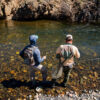
Fly Fishing in late October in the Sun Valley area is a treat with both the fall fishing and foliage hitting its peak. Over the next two weeks, anglers can expect to see sun, rain, and maybe even some snow. The trick to finding good fishing will be to watch the weather and then match your tactics and timing to the conditions. Most mornings you should be able to relax and have a leisurely breakfast before hitting the water allowing the air and water temps to rise. On the calm sunny days, an angler should be ready to use small flies, long leaders, fine tippet and exercise stealth. While on the blustery, cloudy days, an angler should be ready to toss big bugs like terrestrials or get down and dirty with streamers and nymphs. Either way, the fishing should be fantastic.
Silver Creek
The Creek is fishing well on calm days with Baetis (size 20-22), Mahogany Duns (size 16), and midge (size 22-24) on the surface. The surface feeding window is short, from mid to late afternoon until the sun and temperature drops, and it can be sporadic to prolific depending on the day and where you are on the Creek. To find big fish, be patient and search for bank feeders and subtle rise forms. You will often be surprised at how large these fish can be. To fool these wily fish you will need to use the classic Silver Creek skill set including a long leader and fine tippet with “fly first” down or across and down stream presentations. If the wind blows, the rules change; get out your terrestrials and shorten your leader to nine feet and 4x. Nymphs and streamers can also be very effective this time of year; in fact, if you want to consistently catch the larger trout, these are the methods of choice. Your best strategy with these techniques is to locate concentrations of fish and persistently drift or swing your flies through the bucket. The big browns are staging and spawning activity will increase over the next few weeks. As I said in the last report, if they are obviously in spawn mode (on redds), they can be fascinating to watch, but please don’t fish to them and always watch your step around the beds.
Big Wood River
If you get a chance to go fishing over the next two weeks, the Wood is a great choice. It is postcard perfect right now with the cottonwoods in full fall colors. The bugs have been active from about noon till three and that is when you should plan on being on the water. Look for the big fish in the tail outs, the seams along the edges of the fast water, and in the slower dancing water. You can spend the prime hours searching for risers with a long leader and a small Baetis pattern or you can cover the water with a Hecuba dropper or a hopper dropper rig. For the small dries, I like the Baetis Gulper Special with an orange post or the Baetis Hackle Stacker in size 18 or 20. For the hopper, I like the Schroeder’s hopper in size 12 or 10 because it might be mistaken for a Hecuba or a hopper. For nymphs, go small, like an 18, 20, or 22 Zebra midge or Baetis nymph pattern.
Upper and Lower Big Lost
The Upper Lost is low and cold. Bugs are far and few between, but the fish are still hungry. If you go, be cautious and cover a lot of water. You will find some quality trout, just not a lot. This is a great option for spectacular scenery and guaranteed solitude. The better fishing is below Mackay. The flow at the moment is just above 200 CFS and may continue to drop now that the demands for water down stream have diminished. Look for Baetis and a few remaining Tricos during the early to late afternoon for your best chance to find rising fish. Otherwise, nymphing with small Bead Headed Pheasant Tails, Zebra Midge, or other small Baetis nymph imitations will be the most productive. The fishing has been extremely productive for small to medium size fish, but the larger fish have become more difficult. Often the big fish are in the slowest water next to the faster runs and can sometimes be fooled with a light tippet and micro-nymphs on a down stream drift while sight nymphing. They are very spooky, so be stealthy.
Upper Big Lost
If you decide to fish this area be prepared to cover a lot of country. Persistent anglers will be rewarded with some glorious fish…just not very many. If it numbers you want go below Mackay or stay on the Wood. The water in this part of the Lost is low and cold, so focus your attention on the Main Stem of the Upper Lost from the North Fork confluence and down and plan on fishing from about noon on till the sun leaves the water. Since the river is low, the fish are spread out. You can expect there to be maybe one good fish per run with only one legitimate chance at getting a strike…so make it count. Take along an assortment of your favorite attractor dry flies and nymphs as well as your standard parachute patterns: Parachute Hare’s Ear, Turk’s Tarantulas, PMX, Royal Wulffs, King Prince, Flashback PTs and Zebra Midge.
Salmon River
Despite the bone chilling low temperatures in the morning, the Salmon River continues to offer consistent Whitefish and trout fishing. This time of year, large nymphs will result in the highest catch rates as fish store up on food sources before the oncoming cold winter. Take along Prince Nymphs, King Princes, Copper Johns and Caddis Pupae (sizes 12-14) and look for the deep pockets and slower water. Again, the best time to fish is in the early to late afternoon.
Steelhead
If you are considering heading to the Grande Ronde, the Clearwater, or the Lower Snake stop by the shop for the latest information and to stock up on flies. With the rain in the forecast, these fish may really start to move.
South Fork of the Boise
Wading is your best option now that the flows are steady at around 300 CFS. This time of year the fall Baetis and midge are the main players during the comfortable times of the day. Nymphing is also going to be productive when few bugs are about with the usual suspects such as PTs (size 16-20), Zebra Midge (size 18,20), as well as stoneflies and caddis larva imitations. You might also consider streamer fishing to search for an aggressive Bull Trout.
Area Reservoirs
It is that time of year when I begin thinking about spending some time on one of our local reservoirs. Little Camas, Magic, Mackay, or Duck Valley are all going to be fantastic options this time of year. The fish are going to be anywhere from 2 to 4 inches bigger from this spring and just like their brethren in the river they will begin to feed voraciously to fatten up for the onset of winter. So grab some fins and a tube and hold on to your rods…reservoir fish are hot!
Everyone should believe in something. I believe I’ll go fishing.~ Thoreau
photo by Terry Ring




